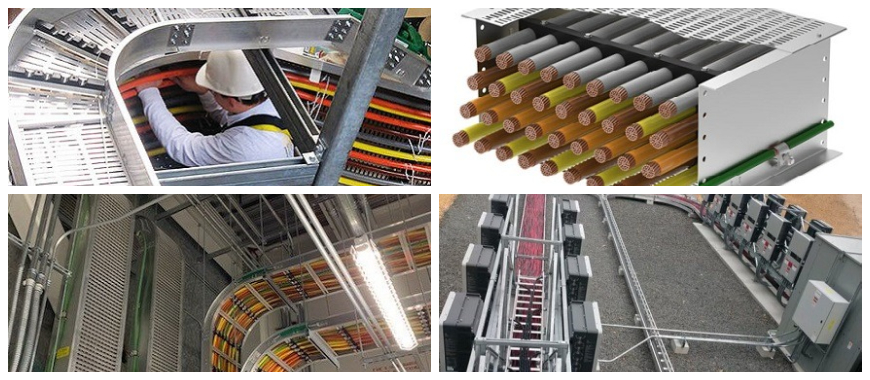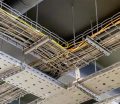
A small cable tray is a compact and versatile solution designed for managing and organizing cables in confined spaces. Ideal for residential, commercial, and light industrial applications, it helps maintain a neat and orderly cable system in areas where larger trays may be impractical. The small cable tray is crucial in preventing cables from tangling, reducing the risk of physical damage, and ensuring efficient cable routing. These trays are especially useful in smaller settings such as home offices, retail spaces, or small-scale industrial installations, where maximizing space while maintaining a tidy and functional cable management system is essential.
Types of Small Cable Tray
Ladder Cable Tray
Ladder cable trays are known for their lightweight structure and open design, which makes them ideal for managing large amounts of cables while ensuring proper airflow. The ladder design, with its horizontal rungs, provides ample space for ventilation, helping to prevent overheating, which is especially important in electrical installations with high power requirements. This type of cable tray is widely used in environments where easy maintenance access is essential, as cables are easily accessible for inspection and upgrades. The open design also minimizes cable damage from physical forces, as cables can hang freely without being confined in an enclosed space. Ladder cable trays are particularly beneficial for applications where air circulation is critical, such as in server rooms or electrical power systems in commercial and industrial settings.
Wire Mesh Cable Tray
Wire mesh cable trays are a highly flexible and easy-to-install option, making them ideal for small offices, homes, or any environment where quick installation and easy adjustments are needed. These trays are typically made of galvanized steel, which offers durability while keeping the system lightweight. Due to their open mesh design, they allow for excellent air circulation, making them a good choice for managing low to medium-voltage cables. The wire mesh system is particularly effective in confined spaces where flexibility and ease of access are crucial. It provides the versatility to support a range of cable types while ensuring that cables are organized and securely held in place. The ease of installation and modification makes wire mesh cable trays perfect for projects that require frequent changes or quick installations.
Flexible Cable Tray Chain
Flexible cable tray chains offer exceptional adaptability for various layouts, making them ideal for environments where the cable management system needs to be frequently adjusted or relocated. Unlike traditional rigid trays, flexible cable tray chains can bend and adapt to various angles and configurations, providing a high degree of customization for complex installations. This makes them suitable for dynamic workspaces, like industrial environments or data centers, where the system needs to adjust to new equipment or changing layouts. Flexible cable tray chains can also be beneficial in installations where space constraints prevent the use of rigid tray systems. Their modular nature ensures that the system can be expanded or contracted easily, making them a practical choice for projects with future growth or reconfiguration plans.
Perforated Cable Tray
Perforated cable trays combine the strength of solid metal with the flexibility of an open design, providing a versatile solution for managing cables in small spaces with limited entry points. The perforated design allows for greater customization in cable routing while maintaining high levels of durability and protection. The holes in the tray serve multiple functions, such as reducing weight, improving airflow, and offering multiple mounting points for cable hangers or accessories. This design is particularly beneficial when space is tight, as it allows cables to be routed efficiently without the risk of overcrowding or tangling. Additionally, the perforated structure can accommodate a variety of cable types, making it a flexible choice for both power and data cables in commercial and industrial settings. The robust construction ensures that cables remain safe from external damage, while the perforations make installation easier and faster.
Improving Safety with a Walkable Checkerboard Cable Tray Cover
Benefits of Using a Small Cable Tray
There are several advantages to using a small cable tray in cable management systems:
- Space Efficiency: The compact design of a cable tray small ensures that even in tight spaces, cable management is optimized. It helps maintain an organized setup without taking up unnecessary room, making it ideal for smaller areas like home offices or compact workspaces.
- Easy Installation: Many small cable trays, such as Kable Kontrol Cable Tray, are easy to install. With minimal tools required, these trays offer quick and straightforward setup, perfect for small-scale applications that require efficient and fast installation.
- Aesthetic Integration: The sleek design of many small cable trays ensures that they seamlessly blend into office or home environments. These trays provide functional cable management while also keeping the space looking neat and visually appealing.
The Essential Features of a Performance Cable Tray System
Choosing the Right Small Cable Tray for Your Needs
When selecting a small cable tray, consider the following factors to ensure you choose the best option:
- Selecting Based on Cable Type: The type of cables you need to manage will influence your choice of small cable tray. For electrical wiring or communication cables, choosing a tray with appropriate capacity and protection is key to preventing damage.
- Material Considerations: Depending on your environment, you may need a more durable material. Industrial-grade options like perforated cable trays offer greater strength, while wire mesh trays provide flexibility and ease of installation for less demanding needs.
- Load Capacity: Ensure the small cable tray you choose can handle the weight and volume of cables in your system. Trays designed to bear heavy loads should be considered for more complex or industrial cable management systems.
Cable Tray Radius: Understanding and Its Applications
Installation Tips for Small Cable Tray
Proper installation of a small cable tray is crucial for maintaining a functional and safe cable management system. Below are some essential tips to ensure a successful installation process:
Planning and Measuring
Accurate measurements are the first step in the installation process. Before installing a small cable tray, measure the available space carefully, considering the tray’s width, length, and the type of cables you plan to use. Ensure that the tray fits properly in the designated area and leaves enough space for airflow and future cable expansion. Pay attention to the location of obstacles such as pipes, beams, or other structures that could interfere with the tray’s installation.
Tools and Materials
Having the right tools and materials on hand before starting the installation is essential. Gather all necessary components, including connectors, supports, mounting brackets, and fasteners. You may also need additional tools such as drills, screws, and levelers. Understanding the installation requirements will help you prepare adequately and streamline the process, ensuring that everything goes smoothly and no steps are overlooked.
Maintenance Considerations
After installation, plan for regular maintenance to keep the system running smoothly. Periodically inspect the tray for signs of wear or damage, especially in areas where cables are heavily used. Ensure that cables are not becoming overcrowded and that the tray continues to provide adequate protection. Regular cleaning and checks for dust, debris, or moisture buildup will help preserve the longevity of the cable tray system.
By following these installation tips, you can ensure that your small cable tray provides an organized, safe, and efficient solution for managing cables in tight spaces. Proper planning, safety, and ongoing maintenance are all critical to achieving optimal results.
Smallest Cable Tray: Ideal for Ultra-Compact Spaces
The smallest cable tray is specifically designed to fit into ultra-compact spaces where larger cable management solutions would be impractical. These trays are particularly beneficial for environments with limited room, such as behind walls, under desks, or in small industrial setups. Despite their small size, these cable trays offer an efficient way to manage and protect cables, ensuring that they remain organized, secure, and easily accessible.
- Space Efficiency: The smallest cable tray is perfect for maximizing the use of tight spaces. Its compact design allows it to be installed in areas where larger trays cannot fit, such as narrow conduits, behind panels, or under desks. This makes it an ideal solution for home offices, small businesses, and industrial facilities with limited space.
- Durability and Strength: Despite their size, these trays are made from durable, high-quality materials such as aluminum or steel, ensuring they are strong enough to support a variety of cables. They can withstand everyday wear and tear, providing long-term cable management solutions even in confined environments.
- Organization and Protection: The smallest cable tray helps prevent tangling, interference, and physical damage to cables. It keeps electrical wiring and communication cables neatly organized while providing protection against dust, moisture, and other environmental hazards.
- Versatility: Due to their small size and flexible design, these trays are highly versatile. They are suitable for both commercial and residential applications, including home offices, small retail stores, and areas with complex wiring systems where space optimization is a priority.
- Easy Installation: The lightweight construction of these trays allows for quick and easy installation, even in confined or hard-to-reach areas. They are often designed to be mounted on walls or ceilings, ensuring that cables are routed securely without taking up valuable floor space.
- Aesthetic Appeal: With their compact design, these trays not only provide functional cable management but also help maintain a clean, organized appearance. Their unobtrusive nature blends well with the aesthetics of modern office spaces or industrial setups, contributing to a tidier, more professional-looking environment.
The smallest cable tray is an excellent choice for ultra-compact spaces, offering both functionality and flexibility in areas where traditional cable management options might not be feasible. Whether you need to organize wiring behind a desk or manage cables in a cramped industrial setting, these trays ensure that your cables remain secure, accessible, and well-protected.
FAQs about Small Cable Tray
The minimum size of a cable tray largely depends on the specific application and the type of cables being routed. Generally, the smallest cable trays are around 50 mm wide, which can accommodate a small bundle of cables. However, cable trays are available in a variety of sizes, ranging from narrow trays that handle small cables to larger trays for heavy-duty cable management. When determining the minimum size for your cable tray, it’s important to consider the diameter of the cables being used, the number of cables, and the amount of space needed for ventilation and ease of future modifications. Additionally, you need to account for factors such as load-bearing capacity and the layout of the installation area. A smaller tray can be used in confined spaces or residential applications, but larger trays are generally required in commercial and industrial settings for better organization and to prevent overcrowding of cables.
There are three primary types of cable trays used in electrical installations: ladder cable trays, perforated cable trays, and wire mesh cable trays. Ladder cable trays are characterized by two side rails connected by rungs, resembling a ladder. These trays are ideal for larger installations and heavy-duty cable management, as they allow for better airflow, reducing the risk of overheating. Perforated cable trays feature a solid sheet of metal with perforations or slots, providing a secure way to hold and organize cables while allowing some ventilation. These trays are commonly used for general-purpose applications and are versatile in both residential and industrial environments. Finally, wire mesh cable trays are made of woven wire mesh, providing an open structure for easy cable routing and ventilation. They are lightweight, flexible, and easy to install, making them suitable for smaller spaces or installations where flexibility is required. Each type of tray offers unique benefits and is chosen based on the specific needs of the project.
The main difference between a cable tray and a ladder tray lies in their design and intended use. A ladder tray consists of two side rails connected by rungs, creating a structure that resembles a ladder. This design allows for easy airflow and efficient cooling of cables, making it ideal for heavy-duty applications where cable bundles are large and ventilation is crucial. Ladder trays are often used in commercial and industrial settings where there is a need for large, organized spaces for numerous cables. On the other hand, cable trays is a broader term that includes various tray types, such as perforated, solid, and wire mesh trays. Cable trays can be made from a variety of materials and designs and can be customized for specific needs, whether for light-duty or heavy-duty cable routing. While ladder trays are a type of cable tray, cable trays encompass a wider range of products, with solid or perforated options providing more flexibility in accommodating different cable types and sizes.
In general, cable trays tend to be more cost-effective than conduit systems, especially when you consider the installation and maintenance costs over time. Cable trays are often easier and faster to install compared to conduit, which requires more labor and materials, particularly when it involves bending, threading, or cutting sections. Cable trays allow for quick and straightforward cable routing without the need for intricate fitting processes, which helps reduce both labor and material costs. Additionally, cable trays offer easier access to cables for maintenance, upgrades, or replacements, whereas conduit systems can be more difficult and costly to modify once they are in place. While the initial cost of cable trays might be lower, the overall savings come from their flexibility, ease of installation, and long-term maintenance advantages. However, the choice between cable tray and conduit depends on the specific needs of the project, such as the type of cables, environmental conditions, and regulatory requirements.

As the editor of GangLong Fiberglass, I have years of experience and in-depth research, focusing on cable tray products, fiberglass solutions, and grille systems. I incorporate years of industry insights and practical experience into every content, committed to promoting the progress of the industry. At GangLong Fiberglass, my commitment is reflected in every product, from innovative cable trays to durable fiberglass solutions and sturdy grille systems. As an authoritative voice in the industry, my goal is to provide valuable information to professionals and businesses and promote forward-looking solutions.


